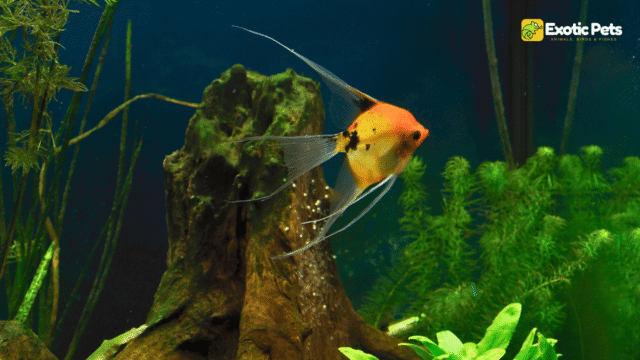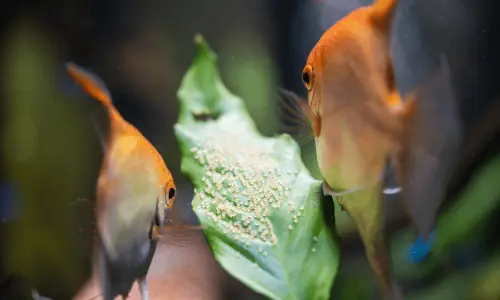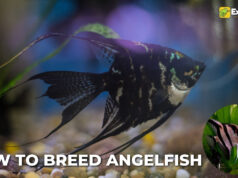
Angelfish (Pterophyllum species) are popular freshwater aquarium fish known for their graceful appearance and relatively easy breeding habits. They are part of the Cichlidae family and are native to the Amazon River Basin in South America. One of the most intriguing aspects of keeping angelfish is witnessing the breeding process, particularly the hatching of angelfish eggs. For many aquarists, this process raises a common question: How long does it take for angelfish eggs to hatch? Understanding the hatching timeline is crucial for proper care and ensuring the successful rearing of angelfish fry.
Angelfish eggs typically hatch within 48 to 72 hours after being laid, depending on various factors such as water temperature, quality, and the health of the breeding pair. The hatching process takes place in the aquarium where the eggs are laid, often on flat surfaces such as leaves, aquarium glass, or specially provided spawning sites.
Knowing the hatching timeline allows aquarists to prepare for the arrival of the fry, adjust tank conditions accordingly, and ensure the safety and well-being of the developing eggs and eventual fry. This knowledge is essential for anyone interested in breeding angelfish or maintaining a thriving angelfish population in their home aquarium. Let’s delve deeper into the captivating world of angelfish egg incubation.
How Long Does it Take for Angelfish Eggs to Hatch?
For first-time angelfish owners, spotting eggs in the tank can be both surprising and exciting. But naturally, questions arise—particularly about the time frame for hatching. Generally, angelfish eggs hatch within 48 to 72 hours under optimal conditions. However, this period can vary based on several factors, such as water temperature, quality, and the genetic traits of the breeding pair.
Key Factors Influencing Hatching Time of Angelfish Eggs
Health of the Breeding Pair: The overall health of the breeding pair also plays a role in the hatching success. A healthy, well-nourished pair is more likely to produce viable eggs with a higher chance of successful hatching. The condition of the parents directly impacts the vitality of the eggs.
Water Temperature: The hatching time of angelfish eggs is highly dependent on water temperature. In warmer water, eggs tend to hatch more quickly. Maintaining a temperature range of 78°F to 84°F (25.5°C to 29°C) is ideal for promoting timely hatching. Cooler water may extend the hatching period to up to 5 days.
Water Quality: Clean, well-filtered water is essential for the healthy development of angelfish eggs. High levels of ammonia, nitrites, or nitrates can delay hatching or cause the eggs to die. Regular water changes and the use of a reliable filtration system are crucial.
Oxygen Levels: Sufficient oxygenation is essential for the embryos’ survival. Angelfish eggs rely on dissolved oxygen in the water for respiration. Inadequate oxygen levels can delay hatching or result in the death of the embryos. To ensure proper oxygenation, it’s important to have efficient water circulation and, in some cases, aeration.
Parental Care: Angelfish are known for their parental instincts. Both parents guard the eggs, fanning them with their fins to ensure a constant flow of oxygen. This care is vital for preventing fungal growth and ensuring the eggs remain healthy.
Also Read: How to Breed Angelfish: A Comprehensive Guide
Angelfish Egg Development: From Laying to Hatching
The Four Stages of Angelfish Egg Development
1. Spawning: The breeding process begins when the female lays eggs on a flat surface, usually prepared by the pair. These eggs are small, round, and vary in color from clear to amber. The male follows closely, fertilizing the eggs as they are laid. This process takes a few hours, during which hundreds of eggs can be deposited.
2. Fertilization: After the female lays the eggs, the male fertilizes them externally. Fertilized eggs will remain attached to the chosen surface, while unfertilized ones may turn white and develop a fungal infection, indicating they should be removed.
3. Incubation: The incubation period is crucial for the development of the embryos. This stage typically lasts between 36 to 48 hours, depending on water conditions. During this period, the parents continue to care for the eggs, protecting them from predators and potential environmental threats.
4. Hatching: As the incubation period ends, you’ll notice the tiny embryos inside the eggs beginning to move. This indicates that hatching is imminent. The actual hatching process can take several hours, with fry gradually breaking free from the egg membrane. Newly hatched fry will initially hang from the spawning site, absorbing their yolk sacs before becoming free-swimming.
Caring for Angelfish Eggs During Incubation
To maximize the chances of successful hatching, it’s important to create an optimal environment for the angelfish eggs. Here are some key steps to follow:
Maintain Stable Temperature: Use a reliable aquarium heater to keep the water temperature between 80-84°F (27-29°C). Sudden fluctuations in temperature can disrupt the development of the eggs.
Ensure Water Quality: Regularly test the water for ammonia, nitrite, and nitrate levels using a water testing kit. High levels of these compounds can be fatal to developing eggs. Regular water changes with conditioned water that matches the tank’s temperature are essential.
Control Light Exposure: Angelfish eggs are sensitive to light. Too much light can be harmful, so it’s best to keep the tank in a dimly lit area or use a light shield to prevent direct light exposure.
Nutrition for the Parents: Feeding the parent angelfish a varied diet of high-quality flake food, live brine shrimp, and other small insects will ensure they have the energy and health needed to care for the eggs.
Also Read: How to Tell if Angelfish Eggs are Fertilized (Expert Tips)
Addressing Common Hatching Complications

Infertile Eggs: If some eggs fail to hatch, they may be infertile. Infertile eggs usually turn white or develop a fungal infection. Remove these eggs promptly to prevent them from contaminating the rest of the spawn.
Fungal Infections: Fungus can be a major threat to angelfish eggs. Adding a small amount of aquarium salt to the water or using a mild antifungal treatment can help prevent the spread of fungus. It’s also advisable to remove any affected eggs to protect the healthy ones.
Stuck Fry: Occasionally, some fry may struggle to break free from the egg membrane. If you notice this, you can gently assist them using a clean tool, but care must be taken not to harm the delicate fry.
Egg Predation: In community tanks, angelfish eggs may be at risk from other fish species that view the eggs as a food source. Even in dedicated breeding tanks, the parent angelfish themselves can sometimes consume the eggs, particularly if they are inexperienced or feel stressed. Providing a safe and controlled environment is crucial for protecting the eggs from predation.
Also Read: 13 Common Angelfish Diseases and Illnesses With Treatment
Raising Angelfish Fry After Hatching
Once the fry has hatched and absorbed their yolk sacs, they will become free-swimming and will require proper care. It’s often beneficial to transfer the fry to a separate rearing tank to protect them from being eaten by other fish, including their parents.
Tank Setup: A separate rearing tank with a sponge filter or a gentle air-driven filter is ideal for fry. This setup ensures that the fry is not sucked into the filtration system and allows them to thrive in clean, oxygen-rich water.
Feeding the Fry: The Fry requires small, frequent feedings. Start with powdered fry food or liquid food, and gradually introduce newly hatched brine shrimp or microworms as they grow. This diet supports rapid growth and development.
Water Quality: Perform regular water changes to maintain clean water and stable water parameters. Using a turkey baster to remove uneaten food and waste from the tank is a good practice to keep the environment healthy.
Additional Insights: Delving Deeper
Beyond the essential information, let’s explore some additional aspects of angelfish egg hatching:
- Candling: Candling is a technique used to assess the fertility of angelfish eggs. By shining a bright light through the eggs, you can observe their development and identify any unfertilized or infertile eggs.
- Egg Appearance: Fertilized angelfish eggs typically appear translucent with a small dark spot in the center, representing the developing embryo. Unfertilized eggs may remain opaque or turn white.
- Parent Fish Behavior: The behavior of the parent fish can offer clues about the progress of egg development. Attentive parents diligently guard and clean the eggs, fanning them with their fins to ensure adequate oxygen flow.
- Fry Development: Once the fry becomes free-swimming, they require a nutritious diet to support their rapid growth. Provide a variety of high-quality foods and monitor their progress closely.
Do Angelfish Eggs Change Color?
Yes, angelfish eggs can change color, and the color change is often an indicator of the eggs’ health and viability:
White Eggs: If the eggs turn white, it typically means they have not been fertilized or have been affected by fungal infections. These eggs should be removed to prevent contamination.
Amber or Brownish Eggs: Fertile and healthy eggs usually appear amber or slightly brownish. This coloration indicates that the eggs are developing properly.
Fungal Infections: Fungal growth on eggs is a sign of poor water conditions or insufficient parental care. Addressing water quality issues and using antifungal treatments can help prevent this.
FAQs: Common Questions About Angelfish Egg Hatching
How do I know if angelfish eggs are fertile?
Fertile angelfish eggs are typically amber and remain attached to surfaces. Unfertile eggs will turn white and may develop fungus.
What temperature do angelfish eggs need?
The ideal water temperature for incubating angelfish eggs is between 80-84°F (27-29°C). Warmer temperatures within this range promote faster hatching.
Can angelfish eggs hatch in the filter?
Yes, angelfish eggs can sometimes be laid on filter intakes. To protect the eggs, consider covering the intake with sponge material during spawning.
Do angelfish eat their eggs or babies?
Angelfish may eat their eggs if they sense something is wrong, such as fungal growth. It’s also common for fry to be eaten if they are not separated from their parents.
What should I do if angelfish eggs turn white?
White eggs are usually infertile or infected with fungus. Remove them to prevent spreading the fungus to other eggs.
How often do angelfish lay eggs?
A female angelfish can lay eggs every 2-3 weeks under optimal conditions.
How many eggs do angelfish lay at a time?
A female angelfish can lay between 100 to 1,000 eggs depending on her size and health.
Conclusion
The hatching of angelfish eggs is a process that requires careful attention to detail and a solid understanding of the factors that influence egg development. From the moment the eggs are laid, aquarists must monitor water temperature, quality, and oxygen levels to ensure a successful hatch. The eggs typically hatch within 48 to 72 hours, but this timeline can be affected by a variety of environmental factors, including water temperature, egg health, and species.
Once the eggs hatch, the focus shifts to the care of the newly emerged fry. Ensuring proper feeding, protection from predators, and maintaining optimal water conditions are key to raising healthy angelfish. While challenges such as fungal infections, egg predation, and inconsistent water conditions can arise, these can be managed with proper knowledge and preparation.
Whether you’re a seasoned angelfish breeder or a novice fishkeeper witnessing this process for the first time, the anticipation and wonder of watching those tiny eggs transform into vibrant fry is an experience that will undoubtedly leave a lasting impression.










